Writer and bookseller Adele Broadbent reviews five New Zealand picture books, including everything from cute creatures to a picture book that tackles PTSD, to a lovely Christmas title.
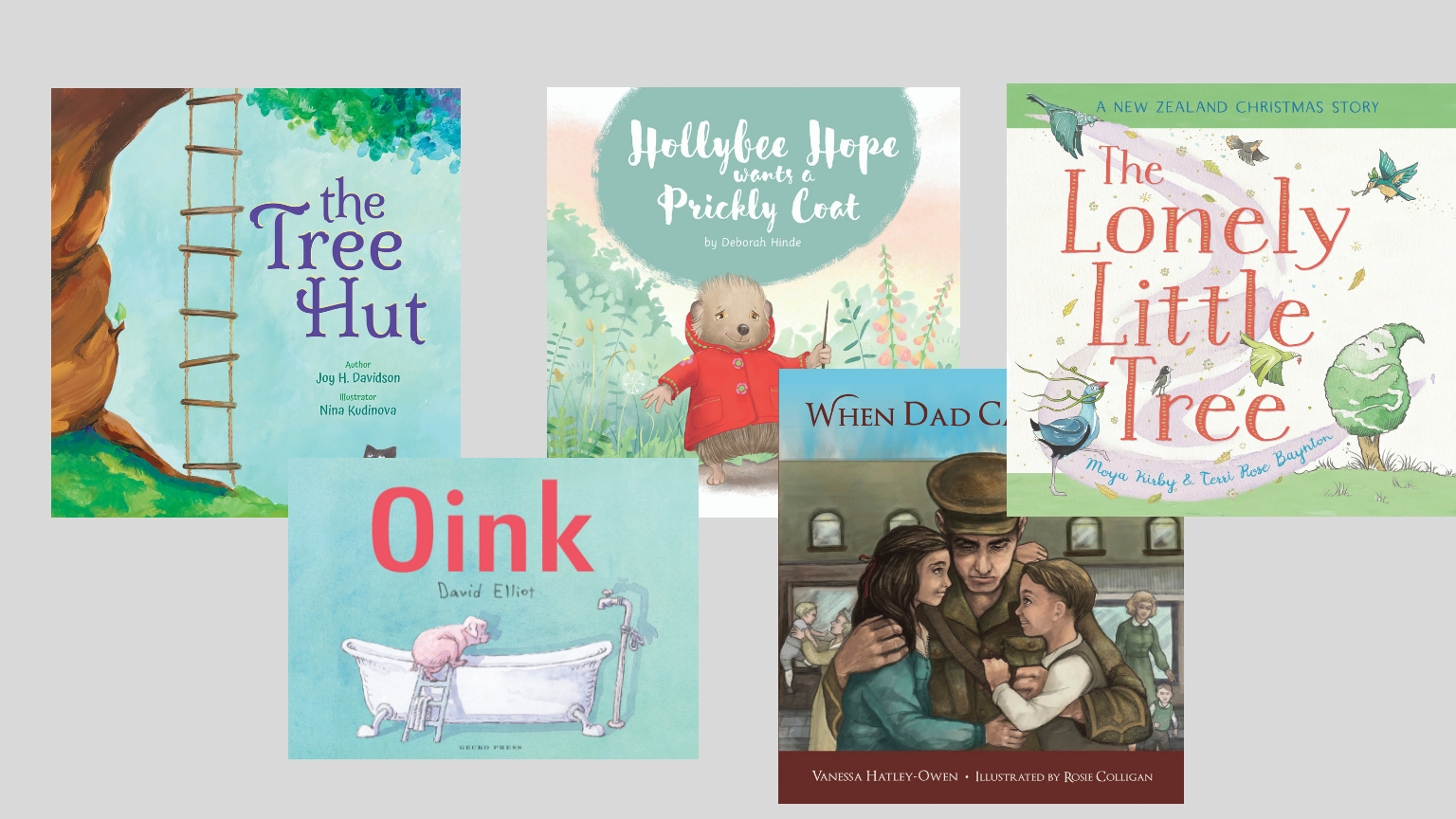
Hollybee Hope wants a Prickly Coat, by Deborah Hinde
Deborah Hinde often shares her cute characters on Instagram, and it was a thrill to see them in action in this picture book. Hollybee Hope wants a Prickly Coat is set at the bottom of a garden that could be anywhere, starring recognisable animals.Hollybee has a problem. Her spines haven’t come through, leaving her back smooth and very un-hedgehog like. How can she be a real hedgehog without spines? Her father assures her they will come, but Hollybee is impatient and wants them now.One day she discovers a bucket with something prickly inside. Can this be the answer? But soon it is more trouble than it’s worth, her friends Basil Bunny and Maddie Mouse coming to her rescue. What about thorns? They are prickly, and will be perfect! But they too have their problems. Feeling glum, Hollybee’s friends decide to take her to see a wise Nana hedgehog, who also lives in the garden. Maybe she can help?
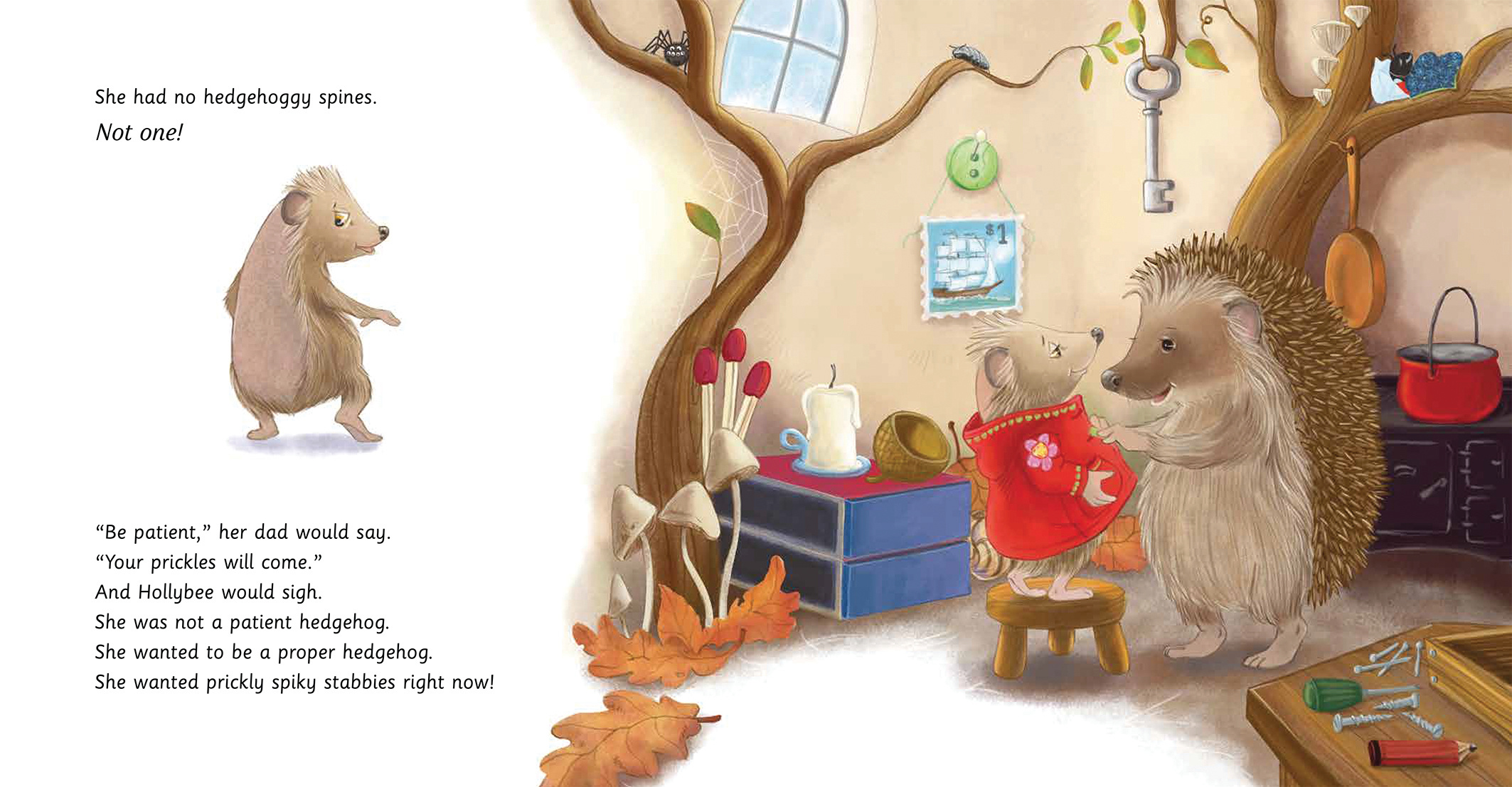
The friends are returning home, happy with the solution, when they hear a sound they all know well. A terrifying sound. The Terror is loose! He is a small terrier, excited to be free and keen to explore. Where can Hollybee and her friends hide? She quickly has the answer, keeping them all safe and scaring off The Terror in the process.The simple story arc of this story from problem identified, possible solutions sought, then a building climax is gentle but exciting, and relatable for children. The dog might be scary to Hollybee and her friends, but Deborah’s choice of a small terrier as opposed to a large dog should ensure young readers aren’t too frightened. Hollybee’s desires to be more than she is at present, can encourage discussions about self-acceptance and accepting differences in yourself and others as a positive thing.
The simple story arc of this story from problem identified, possible solutions sought, then a building climax is gentle but exciting, and relatable for children.
An added extra in the illustrations (as I’ve seen before in Deborah’s books), is a search and find for the ladybird in each double page spread. This is perfect to capture the child not quite ready or keen to sit and listen to the story.
Deborah Hinde is a multi-award winning author and illustrator and has worked with NZ and international publishers on more than 65 books. See here for more about Deborah.
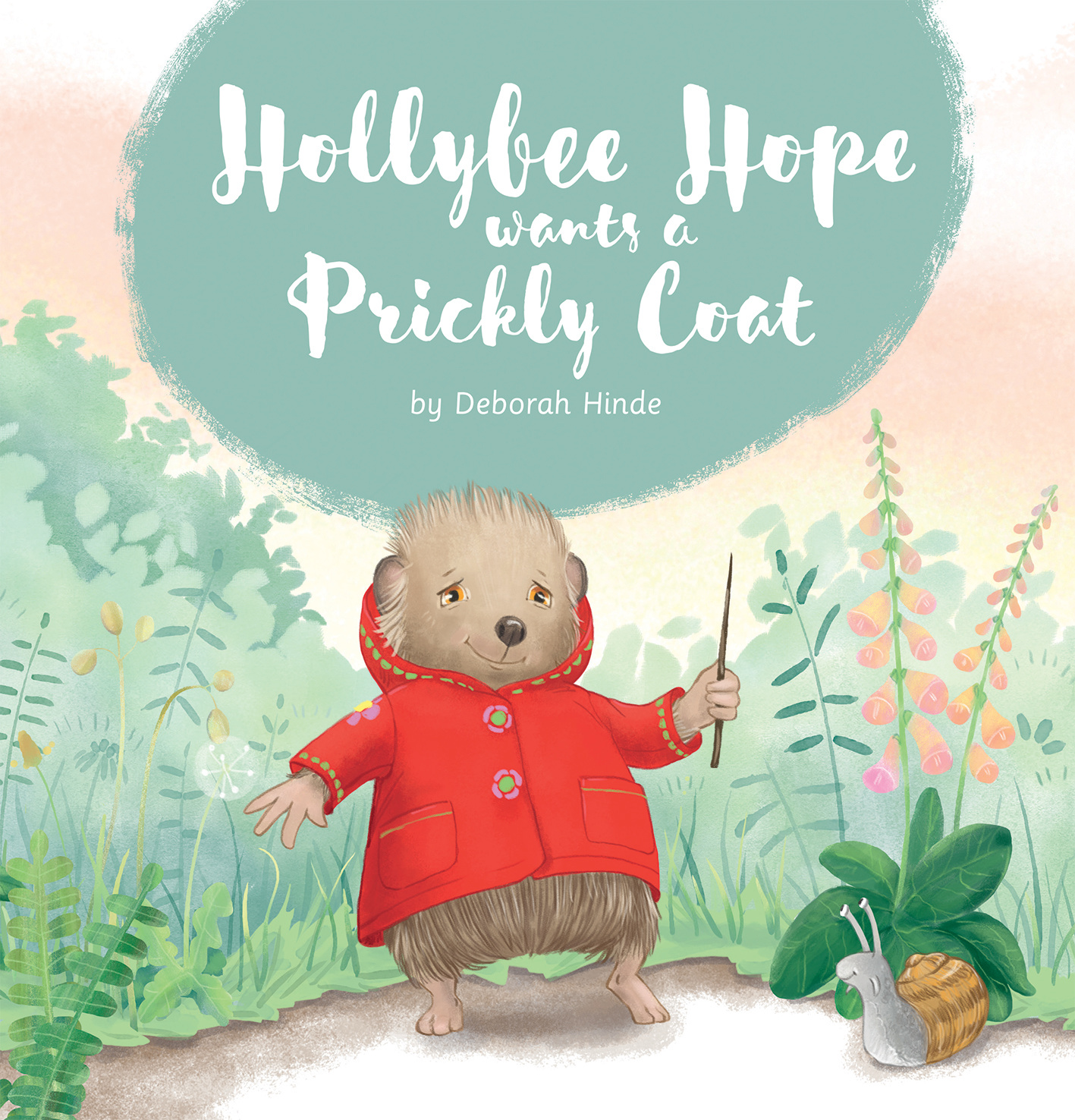
hollybee hope wants a prickly coat
By Deborah Hinde
Published by PictureBook Publishing
RRP: $19.99
Oink, by David Elliot
Oink is another gorgeous production by the team at Gecko Press, and we are introduced to the main character as soon as we open the book. Pig is undressing, then heads towards the bathroom.
When I realised there was no text in this book, I was further intrigued. I knew that the illustrations were to be the sole focus and I looked forward to interpreting them.
Pig’s face is the key, and David Elliot has masterfully portrayed Pig’s thoughts – Pig is looking forward to his bath. He savours the sight of the filled bath from the open doorway, a towel draped over his front hooves. With the bathroom door firmly closed and his fresh, dry towel hanging neatly over a small bath ladder, he climbs in.
Pig’s face is the key, and David Elliot has masterfully portrayed Pig’s thoughts – Pig is looking forward to his bath.
Pig’s pleasure at lying in a bath all to himself is clear. Then comes a knock. Then again. His treasured peace is broken and he sits up, wondering who could it be? It’s Sheep, with a toy boat tucked under her arm. Disbelief radiates from Pig’s face. This look quickly becomes annoyance, as not only does Sheep climb the ladder intending to join Pig, she knocks his neatly folded dry towel off the ladder to the floor. Sheep wants to play, not relax, and soon has her toy boat sailing thunderous seas within the bath.
Further animals continue to arrive in the bath, until there are more animals in the bath than water, his dry towel soaking in a puddle on the floor. As Pig’s disbelief peaks, the unthinkable happens.Silence is sudden. Horror is obvious. Who did it?
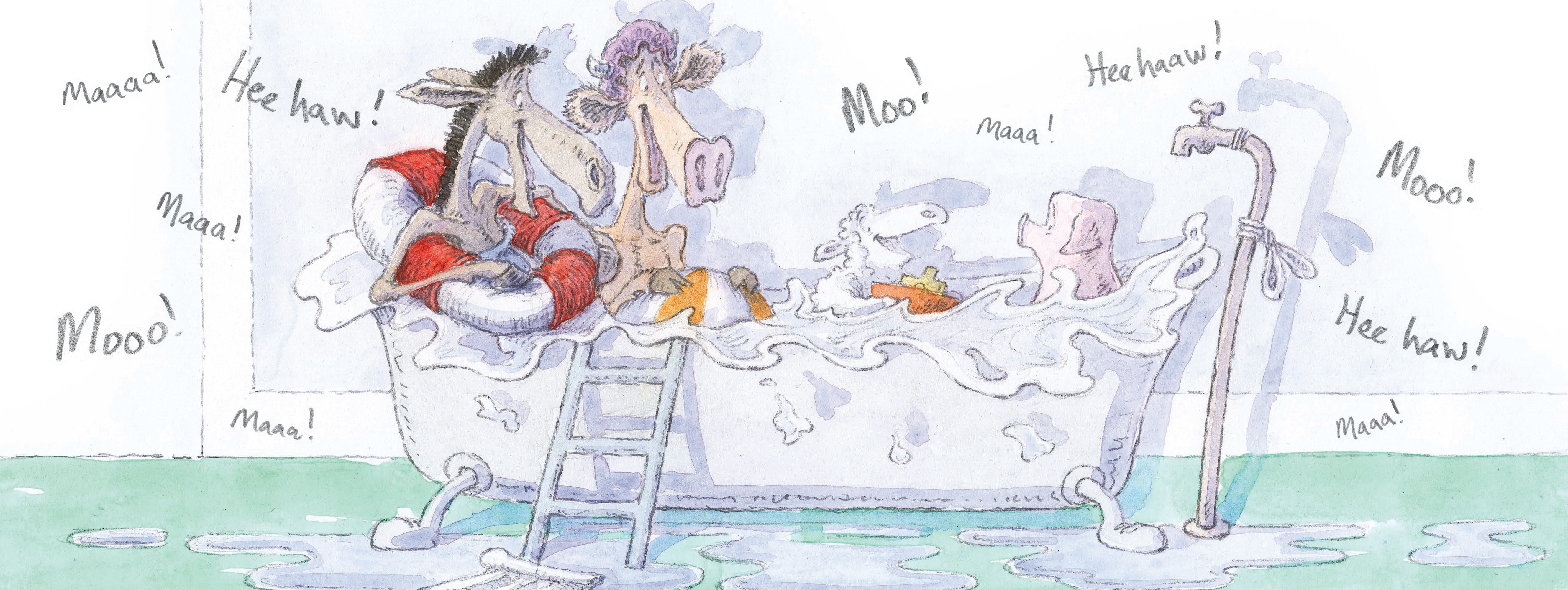
Oink is perfect to be pored over with a young child – slowly interpreting each page by the expressions and actions of the animals. There may be no text, but the animals do speak their own languages in moos, bleats, and calls. These too would be fun to share. The climax made me laugh out loud, (thanks to my inner child) and this touch of toilet humour will delight the reader. Simple, clever and funny.
David Elliot has won multiple awards for his work, including both the Margaret Mahy Book of the Year Award and the Russell Clark Award for Illustration, in 2017.
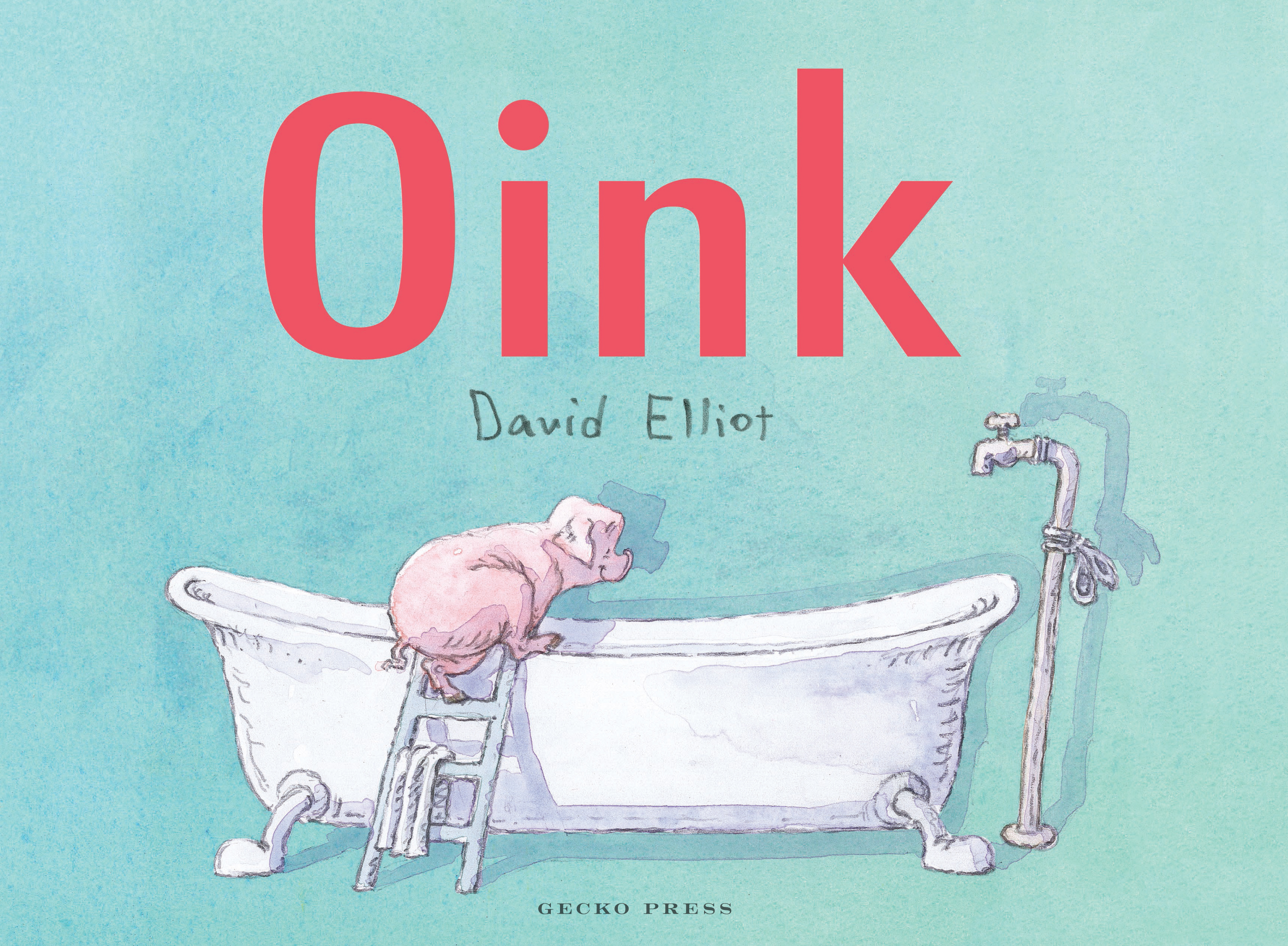
The Lonely Little Tree, by Moya Kirby, illustrated by Terri Rose Baynton
As soon as we open the cover of this book we are greeted with a cheerful swooping tūī. One little tree stands alone at the top of a cliff, at the edge of the sea. She’s lonely, as all her tree friends have been felled and taken from the bluff, leaving only their sad stumps. As the ocean winds flow through and around her, she wonders about her future. A passing bellbird hears her lament and immediately tries to cheer her up.
“Don’t be sad,” said a passing bird, who was swooping low and overheard.”You can be what you want to be –A forest giant, or a Christmas tree!”
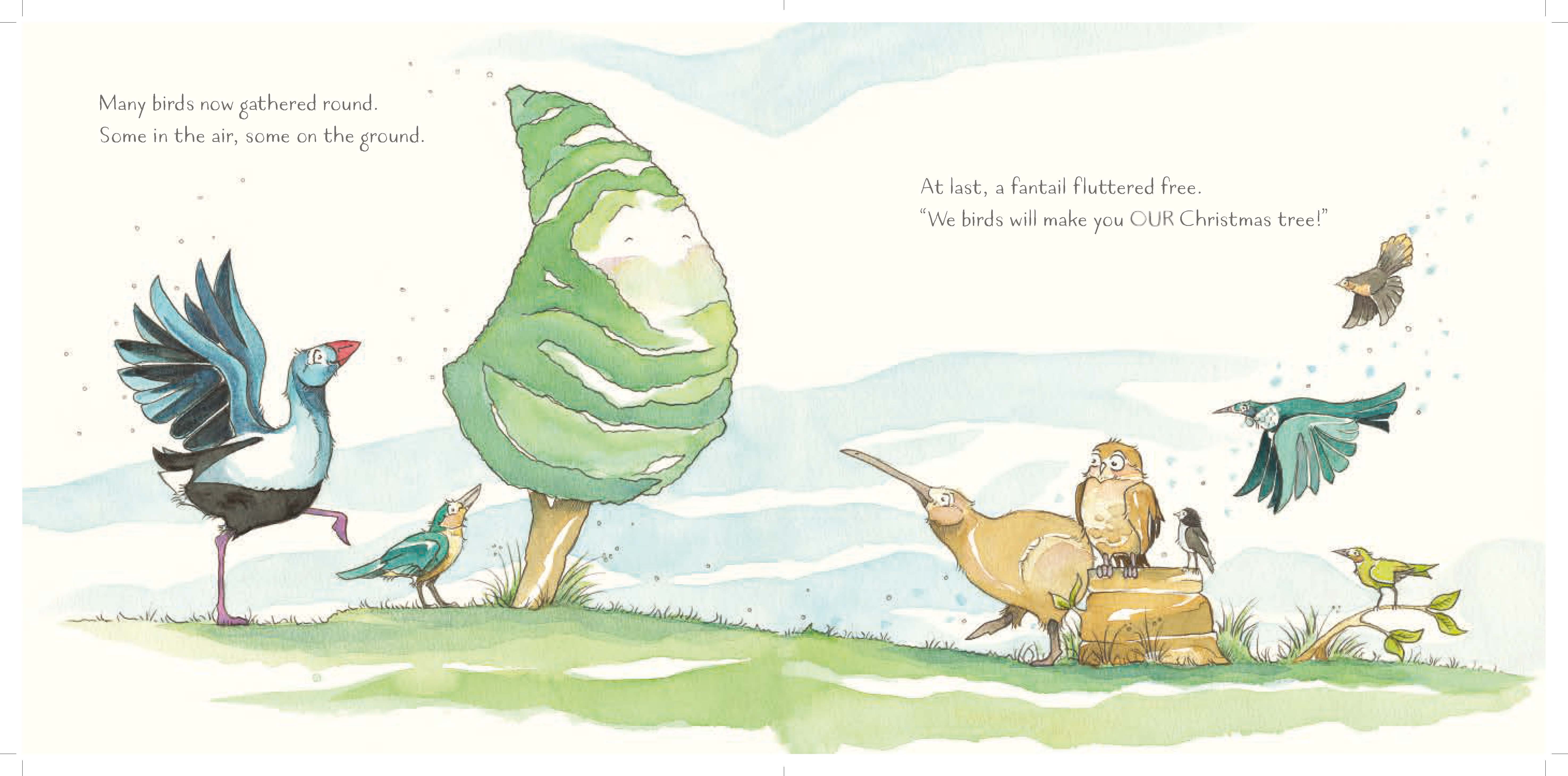
The little tree’s interest is caught, and their conversation attracts other birds. A pūkeko. A kiwi. A tūī, kingfisher and fantail. The tiny flitting fantail is the first to assure the little tree. She could be their Christmas tree. And so begins their project in the age-old NZ can-do DIY way. The birds put their minds together, planning on how to decorate the little tree. Even a spider volunteers her thread for decoration. Rhyming text can be problematic, but in this debut picture book from Moya Kirby, the rhythm is fun and flowing. The positive attitude of the native NZ birds makes this picture book perfect for any young reader or little listener and also a joy to read out loud.
Rhyming text can be problematic, but in this debut picture book from Moya Kirby, the rhythm is fun and flowing.
But how do you show a tree’s feelings? Even without the text, the reader can see the little tree is sad and lonely in the opening of the story. Her feelings of curiosity, happiness and pride then shine through beautifully as her new friends transform her with their gifts. The birds are also simply but clearly drawn and coloured by watercolours, and ample white space has been left to keep the pages uncomplicated for little readers.
But wait… Ruru can see someone coming. Someone with an axe! What should they do? Can they save their little tree friend?
This story was sparked by a drive through an area of felled trees near Gisborne, where Kirby was going to a Christmas party. After a lifetime of writing and performing children’s stories, The Lonely Little Tree is Kirby’s picture book debut.
Terri Rose Baynton is a children’s author and illustrator of several picture books. Her work has also included scriptwriting and storylining for Weta Productions.
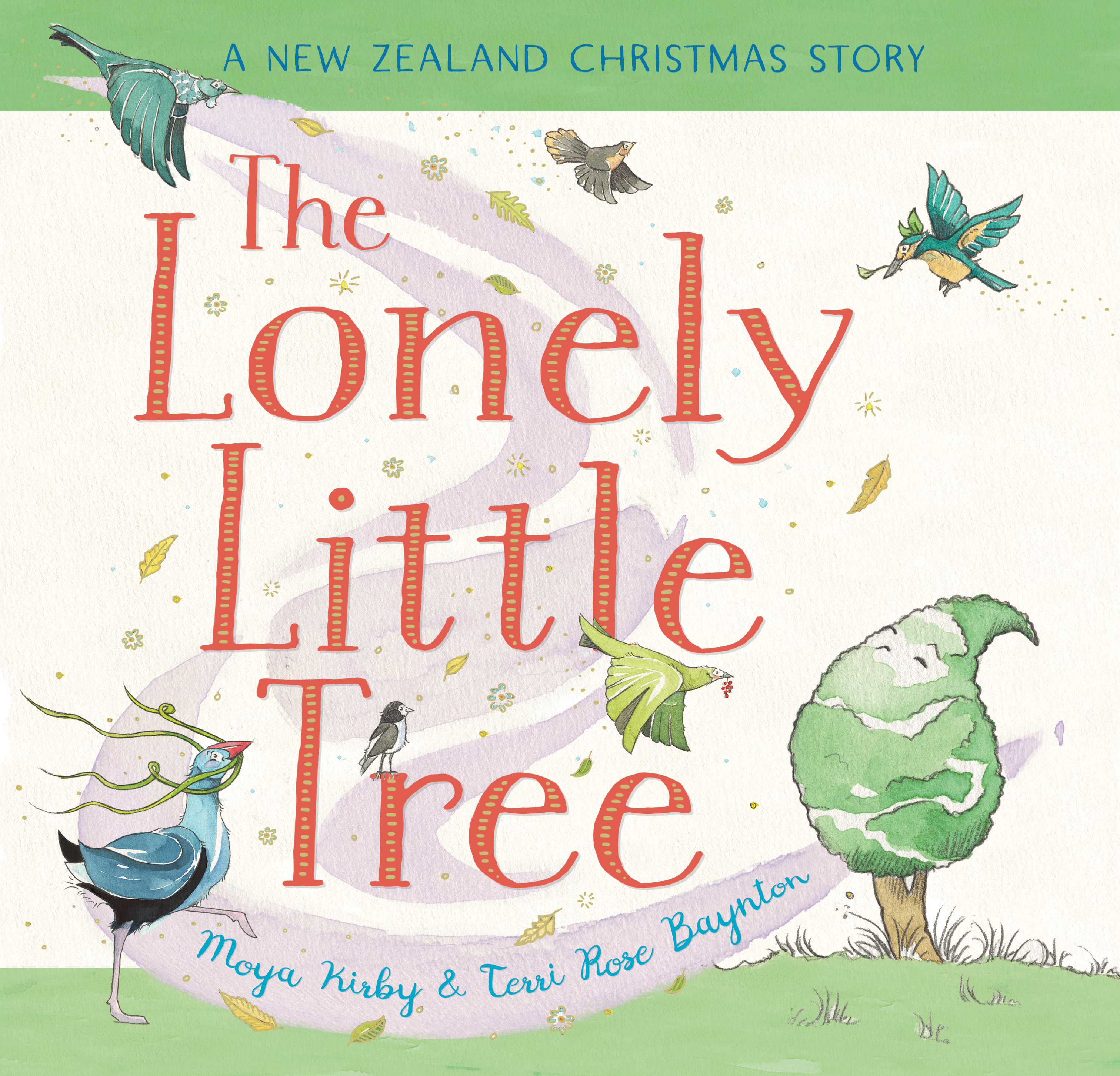
the lonely little tree
By Moya Kirby
Illustrated by Terri Rose Baynton
Published by Scholastic NZ
RRP $19.00
The Tree Hut, by Joy Davidson, illustrated by Nina Kudinova
The cover of this new picture book grabbed me instantly. A simple rope and rung ladder hangs from the top of a tree. Like the real thing, it invites the reader inside to discover more.
Those of us who have had a tree hut will remember that magical feeling of having a space all to ourselves, and the young boy in this story is no different. Jack has to leave his beloved tree hut behind. His father has a new job in the city and Jack and his parents are moving. He’s not happy leaving and isn’t convinced by his parent’s positive comments about living in the city.
Jack’s worries are compounded when his Mum reminds him of his new school. I liked this piece of dialogue and outcome, as we adults often say things with the best of intentions which can sometimes make worries worse. We might see a new school, friends and experiences as exciting, but many children feel only the uncertainty of change.
We might see a new school, friends and experiences as exciting, but many children feel only the uncertainty of change.
Jack’s heart sinks further when there are no trees in his new ‘courtyard’. He doesn’t like the look of the creepy overgrown house next door either. After school the next day, his mum has left a note. She’s gone next door! A high gate, ancient door knocker and dark passage filled with cobwebs, greet Jack as he follows. A hissing cat is the last straw and he whirls to flee, only to find his new neighbour behind him. But she is there to help.
The illustrations portray the moods and tension of the story wonderfully, but one thing did seem out of place. The house itself is shown as overgrown, filled with cobwebs and dark spaces, but the abandoned tree house, which the neighbour shows him, is free of any vines, bushes and weeds that would be inevitable over a length of time.
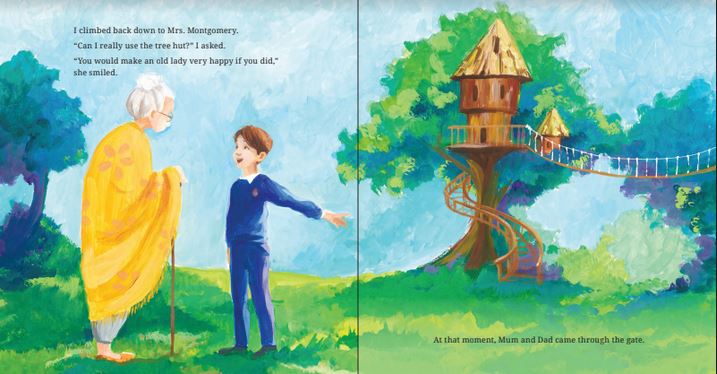
The story arc grabs the reader, capturing many fears and changes of childhood. Moving to a new place. Going to a new school. Imagining horrible things in a creepy house next door. However I found some of Jack’s dialogue was a little old fashioned for someone his age, and wonder if the story would be better in third person.
Joy Davidson was the winner of the Joy Cowley Award in 2015, for Witches Cat Wanted, and was also awarded a Storylines Notable book Award. The Tree Hut is her third picture book. Nina Kudinova is an artist and illustrator from Auckland NZ.
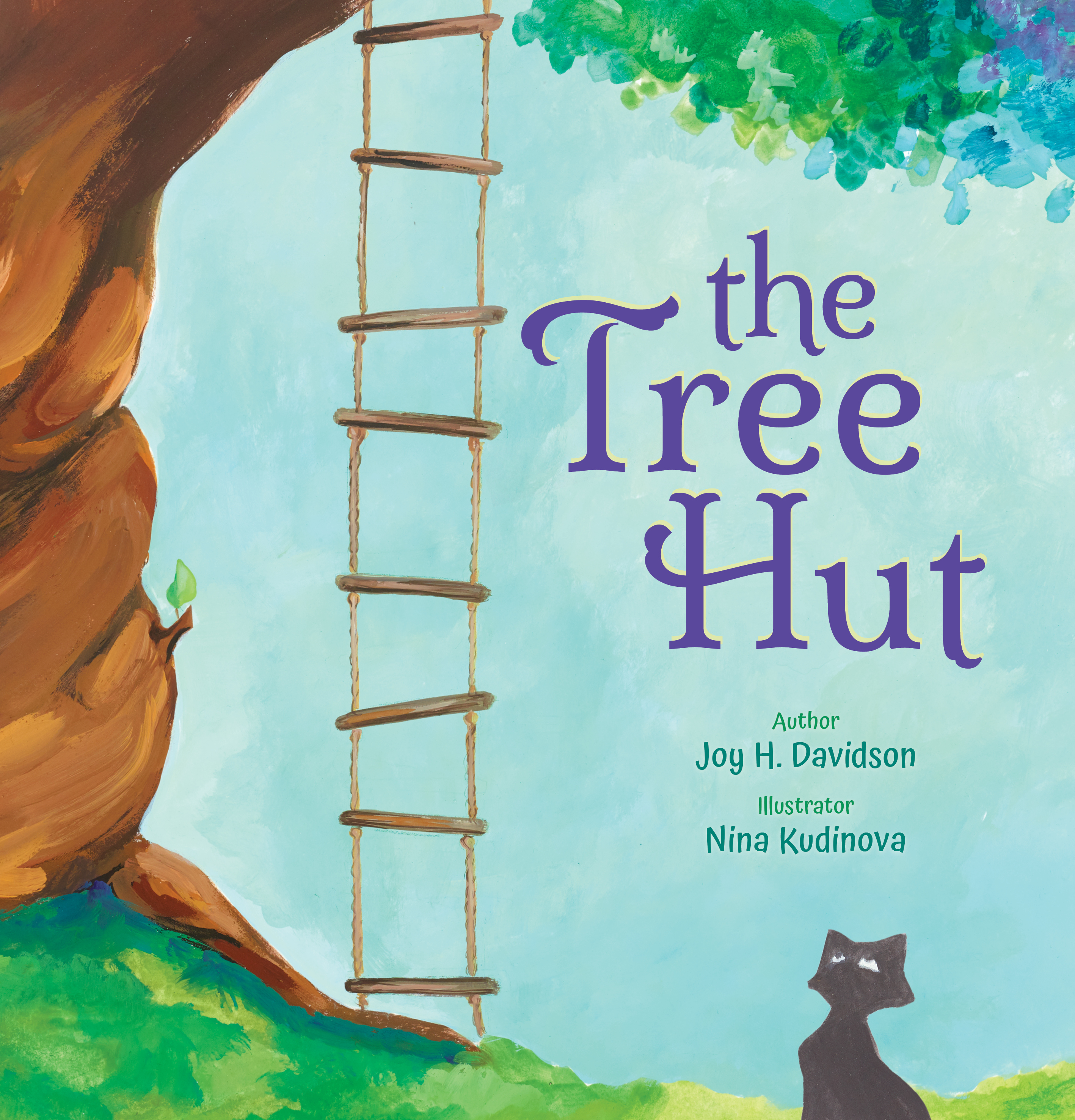
the tree hut
By Joy Davidson
Illustrated by Nina Kudinova
Published by DND Publishing
RRP $20.99
When Dad Came Home, by Vanessa Hatley-Owen, illustrated by Rosie Colligan
Perfectly timed for the centenary of Armistice Day, this story takes the reader back in time to 1918 as bands marched down the streets and people celebrated the end of the First World War.
But even though the long war is over, the wait for their loved ones to return home still remains. When Dad Came Home takes the reader into one family home and we meet Rita (aged about 10), her younger brother Thomas and their mum.
When Dad does arrive, he isn’t the husband or father they remember. He is withdrawn, avoiding visitors and his children. He prefers quiet in the house and any unexpected loud noises terrify him.
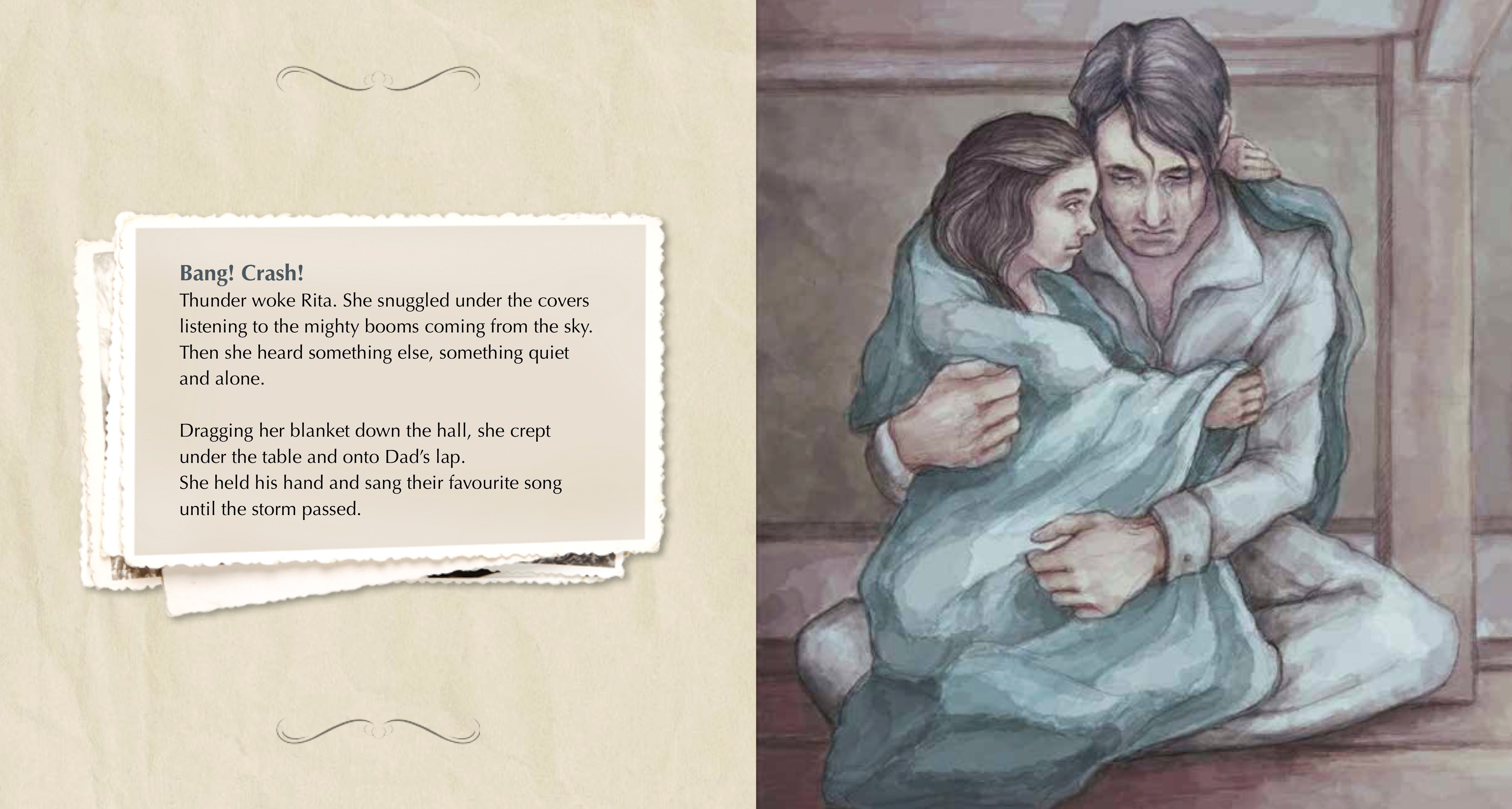
He is a victim of shell shock, or what we now know as Post Traumatic Stress Disorder. At the time, this mental illness was largely misunderstood, and families had to cope with their ‘changed’ men as best they could. When Dad Came Home highlights this illness with the respect it deserves.
Although a sombre subject, there is a thread of lightness spun through this story by first-time author Vanessa Hatley-Owen, linked to Dad’s favourite song. It was played by the celebrating band on the first page and is the thread that holds the family together. While he was away, Mum hummed it while she knitted and baked for him, and Rita would sing it during her chores. Now he is home, this song is something Dad can cling to as he makes his way through his fears and memories, back to his family.
Although a sombre subject, there is a thread of lightness spun through this story by first-time author Vanessa Hatley-Owen, linked to Dad’s favourite song.
Rosie Colligan’s muted colour illustrations took me right into the home, time and feelings of this family. Children’s past times are portrayed in skipping and marbles, Mum is doing physical work while Dad is away, and the formality of visiting other returned service men is felt on the page. Their home is clean and tidy but sparse, and when Dad does arrive, his melancholy and detachment is clear.
The illustration format is varied throughout the story from full double page spreads for the celebrations, to cosy ovals of colour as Dad begins to settle back into civilian life. I particularly liked how the text was displayed on a pile of postcards, although these pages seemed to be quite random.
Vanessa Hatley-Owen has been published in an anthology for children, and by Learning Media. She has also been shortlisted for writing awards. Rosie Colligan is a NZ illustrator based in London. Amongst her work with NZ and international clients, she spent three years with Weta Digital.
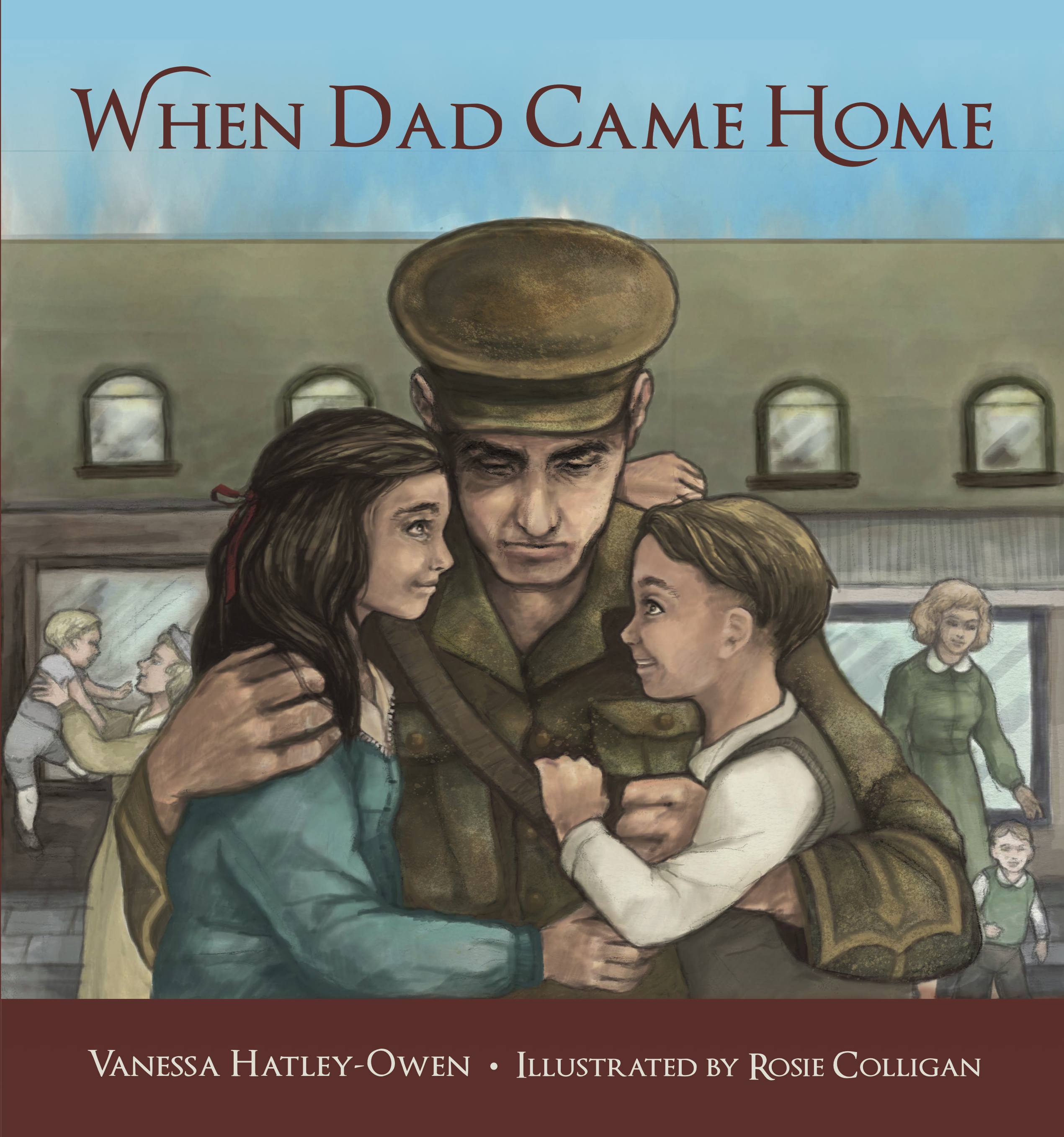
when dad came home
By Vanessa Hatley-Owen
Illustrated by Rosie Colligan
Published by Oratia Media
RRP $19.99

Adele Broadbent
Adele Broadbent is the author of five novels for middle grade readers and several educational titles in the US and Australia. Her latest novel – Between (published May 2018), explores our curiosity in anything a little spooky, supernatural or unexplained.Adele's passion is children's books and she is a self-confessed book nut. She loves collecting outstanding and beautiful children’s books, and feels lucky to be in her dream job as a children’s bookseller at the award-winning Wardini Books in Napier.When Adele isn’t reading or writing or talking about books at Wardini's, she is adding reviews to her children’s and teen’s book review site – www.whatbooknext.com.



